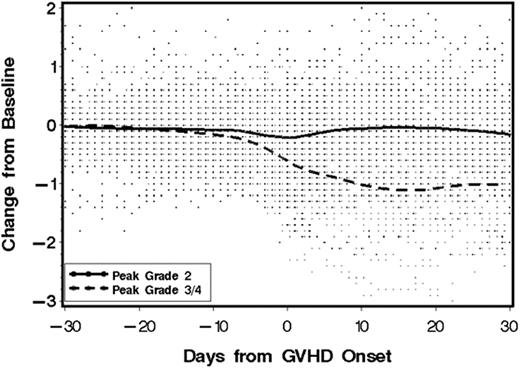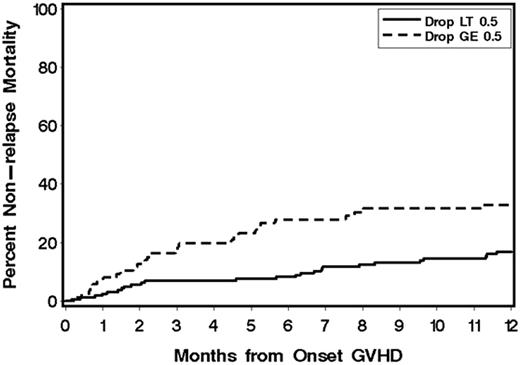Abstract
Abstract 1146
Poster Board I-168
Acute graft-vs.-host disease (aGVHD) varies in its intensity and response to therapy. Biomarkers capable of differentiating treatment-responsive from severe aGVHD at symptom onset may enable risk-stratified therapy. With the advent of prophylactic ursodiol, liver aGVHD has become rare, and gut involvement is responsible for much of the morbidity and mortality associated with severe aGVHD. Protein loss through altered epithelial tight junctions, and ultimately through mucosal necrosis, results in hypoalbuminemia in severe aGVHD (Weisdorf et al., Gastroenterology 1983 85:1076-81). We hypothesized that intestinal protein loss correlated with severity of aGVHD and thus predicted outcome. To test this hypothesis, we retrospectively evaluated changes in serum albumin as a marker of protein loss at the onset of aGVHD symptoms. To reduce the confounding effect of regimen-related gut toxicity, we restricted our analysis to patients who received non-myeloablative conditioning.
Among 708 recipients of a first non-myeloablative allogeneic HCT at our Center, 412 (58%) developed aGVHD grade II–IV. We retrospectively evaluated these 412 patients (336 grade II; 76 grade III/IV). Patients were conditioned with 2 Gy total body irradiation, with or without fludarabine 90 mg/m2. Post-grafting immunosuppression consisted of cyclosporine and mycophenolate mofetil, and corticosteroids were used as first-line treatment of aGVHD. Median patient age was 55 (range, 1–75) years. 170 patients (41%) had related donors. Among the 242 patients (59%) with unrelated donors, there were 31 HLA-allele-mismatched donors, 28 HLA-antigen-mismatched donors, and 6 allele and antigen mismatched donors. We reviewed all serum albumin values from 30 days before to 45 days after clinical onset of aGVHD. The lowest albumin value in the 30 days before HCT was considered a patient's baseline value. Trends in serum albumin before and after aGVHD onset were compared among patients with peak grade II vs. peak grade III/IV aGVHD. We also compared 6-month estimates of non-relapse mortality (NRM) associated with changes in serum albumin and the performance of falling serum albumin as a predictor of grade III/IV aGVHD.
Clinical onset of aGVHD in the study cohort occurred at a median of 35 days after HCT. Patients who went on to develop severe (grade III/IV) aGVHD showed sharp decreases from baseline serum albumin levels; these decreases were already apparent at the onset of clinical aGVHD (Fig. 1). In contrast, patients whose aGVHD never exceeded grade II showed no changes on average from baseline serum albumins at aGVHD onset. Receiver-operator characteristic (ROC) curves demonstrated that among patients with new-onset symptoms of aGVHD requiring treatment, a drop from baseline in serum albumin of 0.5 g/dL optimally discriminated between those who went on to develop severe aGVHD versus those whose aGVHD peaked at grade II (ROC area under curve, 0.75). A drop from baseline albumin of 0.5 g/dL at onset of aGVHD symptoms was also associated with an increased risk of NRM at 6 months after aGVHD onset (28% vs. 8%, HR 2.13 [1.3–3.4], p=0.002; Fig. 2).
A sharp decrease in serum albumin may precede and predict severe aGVHD as well as NRM. Serial measurement of serum albumin is an inexpensive and readily available potential prognostic biomarker in patients with new-onset symptoms of aGVHD after non-myeloablative allogeneic HCT. In combination with other biomarkers or clinical predictors of aGVHD severity, the kinetics of serum albumin may enable specific and risk-stratified targeting of therapies for aGVHD, reserving intensive and protracted immunosuppression for the small percentage of patients at highest risk of severe aGVHD.
FIGURES:
Change from baseline serum albumin concentration (g/dL) at aGVHD onset in patients who subsequently developed peak grade II aGVHD (solid line) vs. peak grade III/IV aGVHD. A decline in serum albumin preceded clinical aGVHD onset in patients who went on to develop severe aGVHD.
Change from baseline serum albumin concentration (g/dL) at aGVHD onset in patients who subsequently developed peak grade II aGVHD (solid line) vs. peak grade III/IV aGVHD. A decline in serum albumin preceded clinical aGVHD onset in patients who went on to develop severe aGVHD.
Decline from baseline serum albumin of ≥0.5 g/dL at clinical onset of aGVHD (dashed line) was associated with elevated NRM. Solid line depicts NRM in patients with decline from baseline serum albumin of <0.5 g/dL at aGVHD onset. Abbreviations: LT, less than; GE, greater than or equal to.
Decline from baseline serum albumin of ≥0.5 g/dL at clinical onset of aGVHD (dashed line) was associated with elevated NRM. Solid line depicts NRM in patients with decline from baseline serum albumin of <0.5 g/dL at aGVHD onset. Abbreviations: LT, less than; GE, greater than or equal to.
No relevant conflicts of interest to declare.
Author notes
Asterisk with author names denotes non-ASH members.



This feature is available to Subscribers Only
Sign In or Create an Account Close Modal